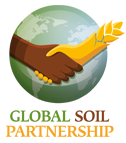The second session of the Plenary Assembly of the Global Soil Partnership (GSP) has endorsed a number of measures to safeguard soil resources, including four Plans of Action, a global soil information system, a capacity development program, and a report on world soil resources.
Recommendations of the Plans of Action include strong government regulations and investments for sustainable management of soils that contribute to the eradication of hunger, food insecurity and poverty.
 24 July 2014: The second session of the Plenary Assembly of the Global Soil Partnership (GSP) has endorsed a number of measures to safeguard soil resources, including four Plans of Action, a global soil information system, a capacity development program, and a report on world soil resources. Recommendations of the Plans of Action include strong government regulations and investments for sustainable management of soils that contribute to the eradication of hunger, food insecurity and poverty.
24 July 2014: The second session of the Plenary Assembly of the Global Soil Partnership (GSP) has endorsed a number of measures to safeguard soil resources, including four Plans of Action, a global soil information system, a capacity development program, and a report on world soil resources. Recommendations of the Plans of Action include strong government regulations and investments for sustainable management of soils that contribute to the eradication of hunger, food insecurity and poverty.
The GSP Plenary Assembly, held in Rome, Italy, from 22-24 July, which included participation by both government and non-government stakeholders, endorsed Plans of Action for four GSP Pillars, namely: promoting sustainable management of soil resources; encouraging investment, technical cooperation, policy, education, awareness and extension in soils; enhancing the quantity and quality of soil data and information; and supporting the harmonization of methods, measurements and indicators for sustainable soil management.
Under the Plans of Action, the Assembly endorsed the establishment of a Global Soil Information System to monitor and forecast the conditions of the Earth’s soil resources. The system will use data from national and within-country systems and deliver products and information services for regional and global purposes, including achieving the Sustainable Development Goals (SDGs). The Plans of Action also incorporate programmes on: the promotion of sustainable soil management; capacity development; education and extension; and an overarching system for harmonized soil characterization.
Stressing the life-sustaining role of soils and the non-renewability of lost soils over a human lifetime, Maria Helena Semedo, Deputy Director-General of the Food and Agriculture Organization of the UN (FAO), called for commitments from countries and civil society to implement the Plans of Action, pointing out that this requires political will and investments.
Experts at the meeting also emphasized: the limited area of productive soils in the world; pressures from population growth and competing soil uses, including cropping, forestry, pastures, urbanization and energy production; that one-third of soils are degraded; and interlinkages between soils and climate change.
The Plenary Assembly also noted the upcoming launch of the first ‘Status of World Soil Resources Report’ on 5 December 2015, coinciding with the annual UN World Soil Day and the International Year of Soils 2015, among other related activities.
Other issues considered included: a proposed update of the World Soil Charter and a progress report by the GSP’s Intergovernmental Technical Panel on Soils (ITPS); and an update on the establishment of the Healthy Soils Multipartner Platform and a report on the achievements under Regional Soil Partnerships by the GSP Secretariat.
The GSP, hosted by the FAO, brings together a broad range of stakeholders stressing the need for governments to preserve soils. The GPS Plenary Assembly is the main yearly meeting of ITPS members, GSP Secretariat, partners, and FAO members. [FAO Press Release] [UN News Centre Press Release] [GSP Second Plenary Assembly Session Agenda] [GSP Website][International Year of Soils Webpage] [GSP Plenary Outcomes] [IISD RS Sources]